
ARE YOU OF LEGAL VAPE AGE?
Please confirm that you are of legal age to purchase vaping products to access our site.

Please confirm that you are of legal age to purchase vaping products to access our site.
Some items are no longer available. Your cart has been updated.
This discount code cannot be used in conjunction with other promotional or discounted offer.
This study employs direct injection methods to conduct quantitative gas chromatography (GC) analysis and qualitative gas chromatography-mass spectrometry (GC-MS) analysis on three mango-flavored e-liquids. The results indicate that Sample A identified 57 volatile compounds, Sample B identified 39 volatile compounds, and Sample C identified 72 volatile compounds. Among these, the three mango-flavored e-liquids share five major components (above 0.1% content): propylene glycol, glycerol, benzoic acid, WS-23, and nicotine. Sample A has four unique components, Sample B has three unique components, and Sample C has nearly 15 unique components. Through imitation flavor experiments, VAPEPIE successfully formulated a mango-flavored e-liquid that achieves consistency with the natural aroma of mango.
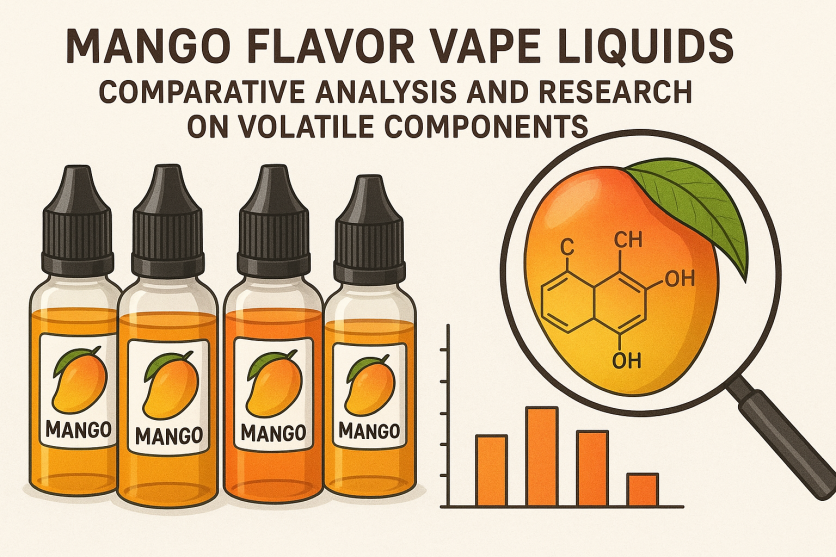
In recent years, the e-cigarette market has experienced rapid growth, with global sales reaching nearly $14.52 billion. Current e-cigarette products offer a more diverse range of flavors, among which tropical fruit flavors are particularly favored by consumers. Mango flavor serves as a typical representative of tropical fruit e-liquids. Sensory evaluations reveal differences in aroma characteristics among mango-flavored e-liquids from different brands, suggesting variations in their chemical compositions. VAPEPIE analyzed the volatile components in three mango-flavored e-liquids from three companies and conducted a comparative study, aiming to provide valuable references and assistance for the development and quality evaluation of tropical fruit-flavored e-liquid products.
The e-cigarette industry has surged in popularity, driven by innovative flavors and consumer preferences for alternatives to traditional smoking. Mango-flavored e-liquids, as a staple in tropical fruit categories, exhibit distinct aroma profiles across brands. This research focuses on the volatile components analysis of mango e-liquids to enhance understanding of their chemical makeup, supporting product innovation and safety assessments in the vaping sector.
Three mango-flavored e-liquid samples (A, B, and C) were purchased from Taobao in 2020, each produced by different companies.
Agilent 5977B GC-MS system (USA) and Agilent 7890B gas chromatograph (USA).
A 0.8 μL sample of e-liquid was directly injected. Chromatographic conditions: Column type HP-5MS (60 m × 0.25 mm × 0.25 μm); Injection port temperature: 250°C; Column head pressure: 58 kPa; Injection mode: 40:1 split; Temperature program: From 50°C, ramp at 4°C/min to 250°C, hold for 10 minutes.
Mass spectrometry conditions: EI source, electron energy: 70 eV; Electron multiplier voltage: 1800 V; Mass scan range: 33-350 amu; Ion source temperature: 230°C; Transfer line temperature: 280°C; NIST11 library search.
Compounds were identified via NIST library search combined with manual mass spectrum interpretation. Relative contents were calculated using peak area normalization (percentage of peak area).
Figure 1 3 GC-MS total ion chromatograms of volatile components of Mango-Flavor Vape oils
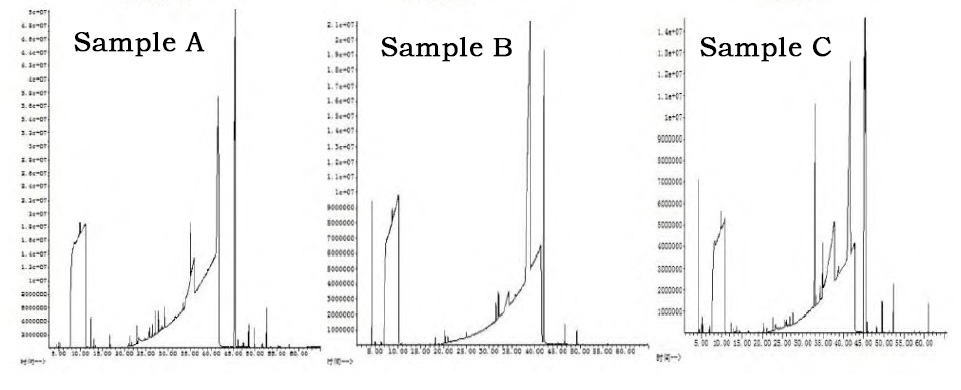
Using the above experimental methods, GC-MS analysis was performed on the three mango-flavored e-liquids, yielding total ion chromatograms as shown in Figure 1. Computer searches against the standard mass spectral library were conducted, with compounds having a reliability above 80% considered identified. GC analysis, combined with peak area normalization, identified a total of 81 volatile components (Table 1). Sample A identified 57 volatile compounds, Sample B identified 39, and Sample C identified 72. The sum of identified compound peak areas accounted for 99.882%, 99.983%, and 99.972% of the total volatile component peak areas in the direct injection samples, respectively.
Table 1 Analysis of volatile components in three mango-flavored e-cigarette liquids
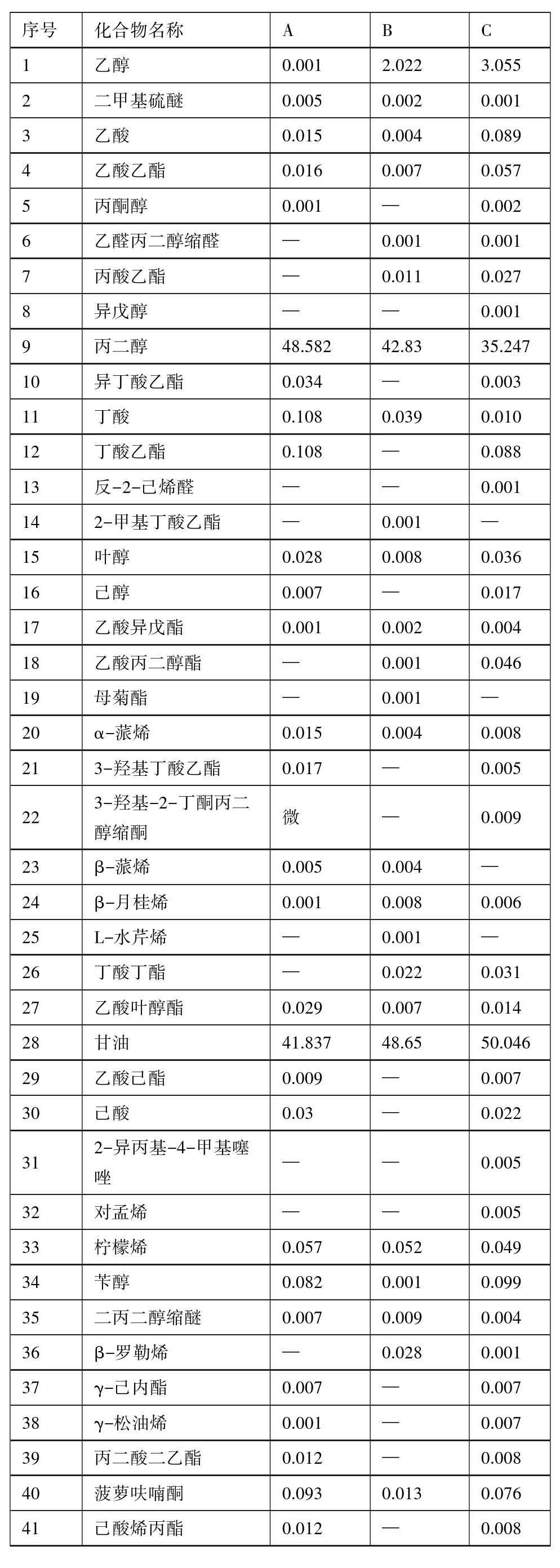
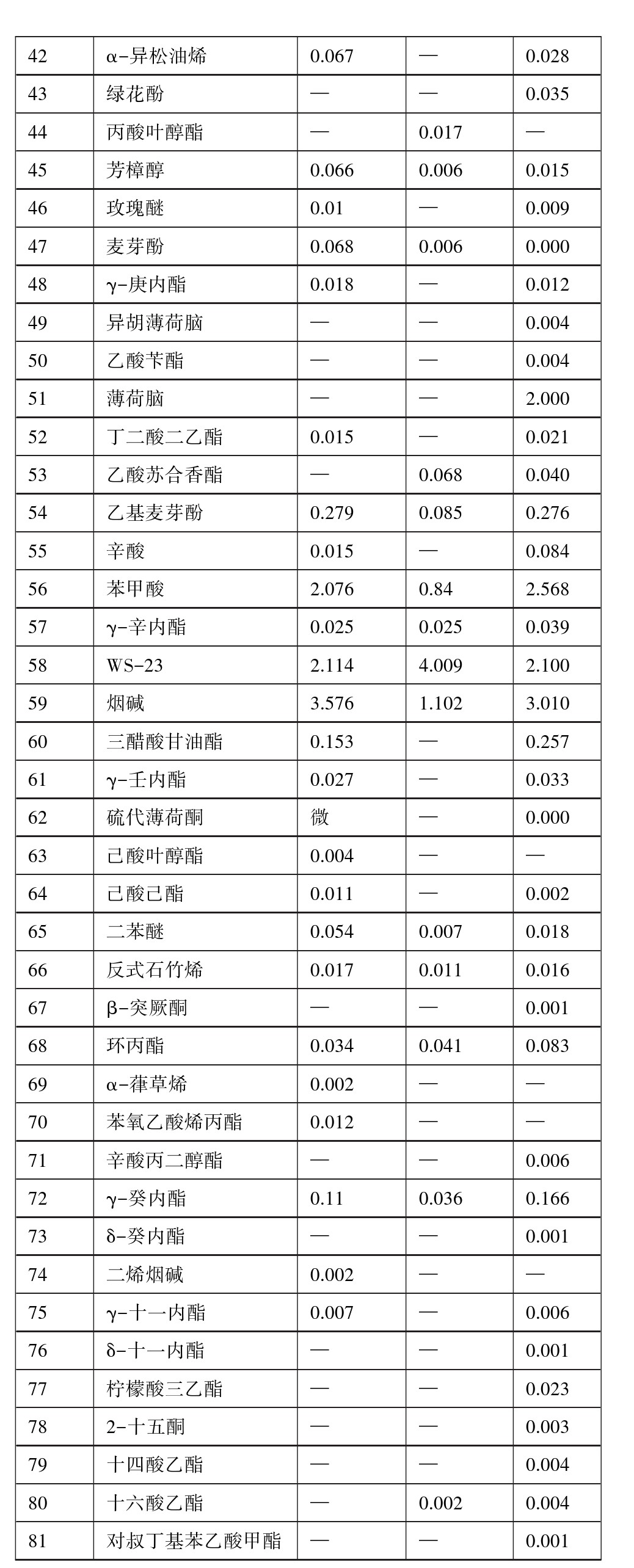
Comparative Analysis of Aroma-Contributing Components in Three Mango-Flavored E-Liquids
From Table 1, Sample C has 33 more component types than Sample B, highlighting significant differences despite sharing the same mango flavor. Among the detected compounds, 27 are common to all three e-liquids: ethanol, dimethyl sulfide, acetic acid, ethyl acetate, propylene glycol, butyric acid, leaf alcohol, isoamyl acetate, α-pinene, β-myrcene, leaf alcohol acetate, glycerol, limonene, benzyl alcohol, dipropylene glycol ether, furaneol, linalool, maltol, ethyl maltol, benzoic acid, γ-octalactone, WS-23, nicotine, diphenyl ether, trans-caryophyllene, cyclopropyl ester, and γ-decalactone. Among these, the major ones with higher content are propylene glycol, glycerol, nicotine, benzoic acid, and WS-23, with their combined relative contents being 98.185%, 97.431%, and 92.971% in the three samples, respectively.
Sample A's unique components are hexyl leaf alcohol ester, α-terpinene, allyl phenoxyacetate, and diene nicotine. Sample B's unique components are ethyl 2-methylbutyrate, matricaria ester, and L-phellandrene. Sample C has 15 unique components, with higher amounts including eugenol and triethyl citrate.
In Sample A, 10 volatile components exceed 0.1% content: propylene glycol, butyric acid, ethyl butyrate, glycerol, ethyl maltol, benzoic acid, WS-23, nicotine, triacetin, and γ-decalactone, summing to 98.943% of total peak area.
In Sample B, 6 components exceed 0.1%: ethanol, propylene glycol, glycerol, benzoic acid, WS-23, and nicotine, summing to 99.453%.
In Sample C, 10 components exceed 0.1%: ethanol, propylene glycol, glycerol, menthol, ethyl maltol, benzoic acid, WS-23, nicotine, triacetin, and γ-decalactone, summing to 98.725%.
Analysis of components above 0.1% shows that the main framework of mango-flavored e-liquids consists of propylene glycol, glycerol, benzoic acid, WS-23, and nicotine, with sums of 98.185%, 97.431%, and 92.971% in each sample.
The primary atomizing agents detected are propylene glycol and glycerol, which offer excellent atomization, moisturizing, and lubricating effects, and serve as good solvents. While propylene glycol's safety for direct contact or ingestion is well-studied and regulated, its inhalation safety remains controversial. Recent research by Gao Yihan et al.indicates a NOEL of 100 mg/kg for 90-day rat inhalation of PG aerosol, equivalent to dozens of times the maximum daily e-cigarette usage, with no significant toxicity.
Triacetin, a colorless, odorless oily liquid used as a flavor fixative and solvent, is uncommon in e-liquids but may be introduced via mango-flavored food essences.
WS-23, present in all samples, is a novel cooling agent characterized by freshness, longevity, non-irritating spiciness, no bitterness, and low dosage.
Dimethyl sulfide, a trace sulfur-containing flavor in all samples, has a strong aroma, low threshold, and enhances fruit essence realism.
Sensory quality evaluation was conducted by the e-cigarette tasting panel at Shenzhen Boton Flavor Co., Ltd., using a 9-point scale across eight indicators: aroma quality, aroma quantity, off-notes, concentration, throat hit, irritation, sweetness, and aftertaste (Table 2). Ratings: C > A > B. Sample C's nearly 20 unique volatile components likely contribute synergistically to improved vaping quality.
Table 2 Sensory evaluation of e-cigarette liquids with different flavors
| Sample | Score | Evaluation Result |
|---|---|---|
| A | 54.1 | Smoke is mellow, good harmony, aftertaste acceptable, slight astringency on the tongue |
| B | 52.2 | Aroma is off, average harmony, throat feels dry after smoking |
| C | 56.8 | Good aroma quality, sufficient aroma intensity, pleasant sweetness, residual sensation on the tongue |
Combining component analysis and sensory evaluation, an initial formulation was developed and refined through repeated trials and evaluations to optimize the imitation e-liquid (Table 3).
Table 3 Optimized formula of Mango Vape
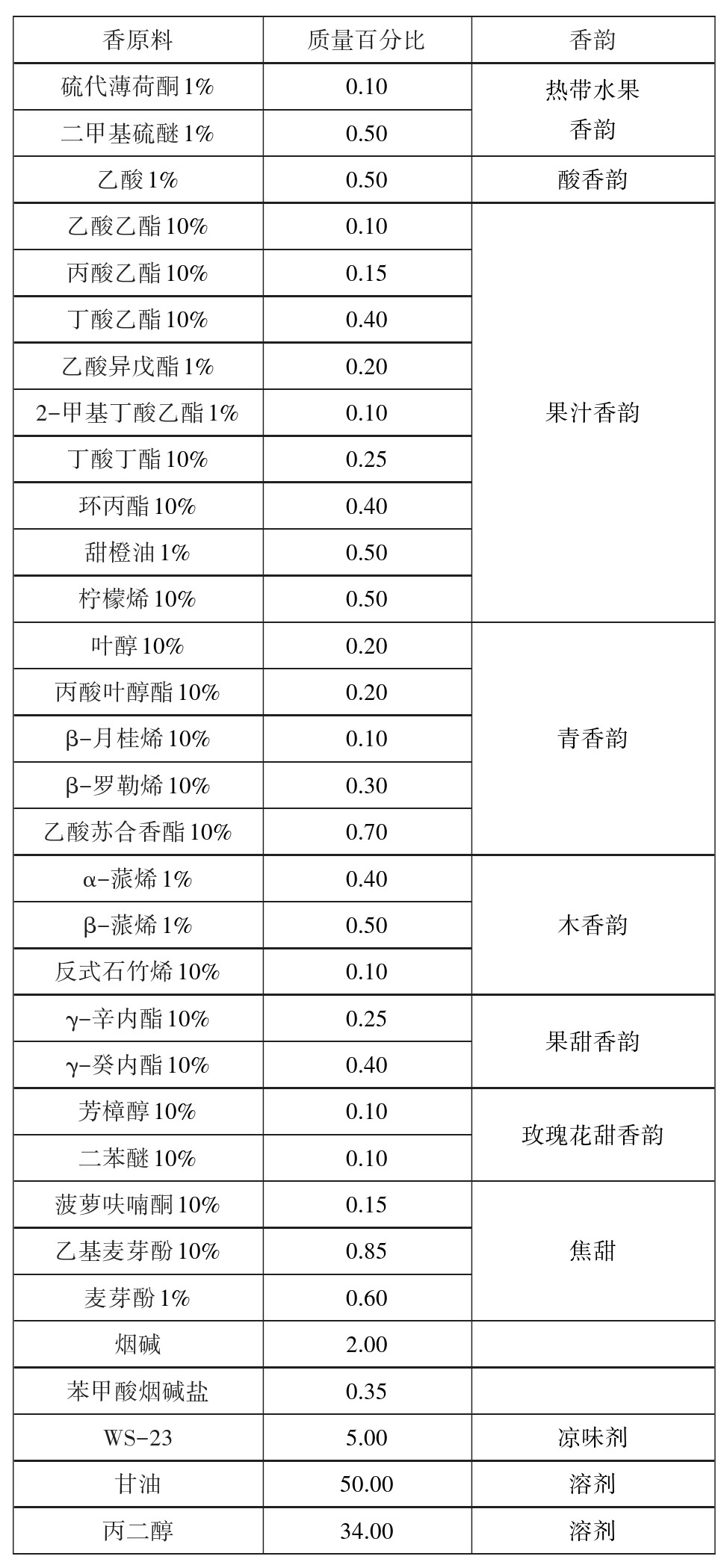
The final imitation e-liquid includes 32 raw materials, mostly synthetic flavors for cost reduction, with some natural ones for authenticity. Proportions: 1.1% tropical fruit note, 2.6% fruit juice note, 1.5% green note, 1% woody note, 0.65% fruit sweet note, 0.2% rose sweet note, 1.6% caramel sweet note, 5% cooling agent, 84% solvent. Sensory evaluation confirms it closely mimics ripe mango, with robust tropical fruit characteristics, full body, harmony, and good persistence.
Sour Mango Pineapple Flavor Vape
Mango Pineapple Peach Flavor Vape
This study uses direct injection to identify volatile components in popular Mango Flavor Vape, totaling 81 compounds, primarily atomizers, cooling agents, and characteristic aroma contributors. The formulated mango-flavored e-liquid, based on component analysis and flavoring techniques, exhibits rich aroma, natural progression from top to base notes, and layered sensory experience, suitable for commercial e-liquid product development.

Comment